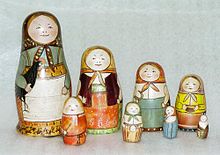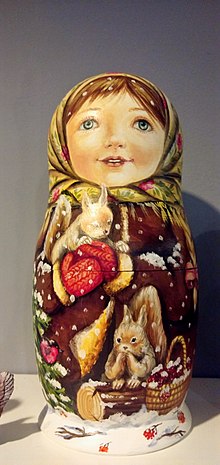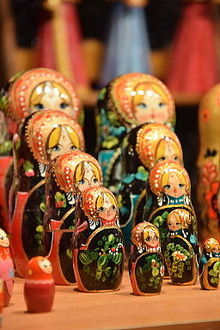Matryoshka doll
 Matryoshka dolls set in a row | |
| Other names | Russian doll |
|---|---|
| Inventor(s) | Vasily Zvyozdochkin (manufacturer), Sergey Malyutin (design) |
| Country | Russia |
| Availability | 1890–present |



Matryoshka dolls (/ˌmætriˈɒʃkə/ MAT-ree-OSH-kə; Russian: матрёшка, IPA: [mɐˈtrʲɵʂkə] ⓘ), also known as stacking dolls, nesting dolls, Russian tea dolls, or Russian dolls,[1] are a set of wooden dolls of decreasing size placed one inside another. The name matryoshka, mainly known as "little matron", is a diminutive form of Matryosha (Матрёша), in turn a diminutive of the Russian female first name Matryona (Матрёна).[2]
A set of matryoshkas consists of a wooden figure, which separates at the middle, top from bottom, to reveal a smaller figure of the same sort inside, which has, in turn, another figure inside of it, and so on.
The first Russian nested doll set was made in 1890 by
History

The first Russian nested doll set was carved in 1890 at the Children's Education Workshop by Vasily Zvyozdochkin and designed by Sergey Malyutin, who was a folk crafts painter in the Abramtsevo estate of
The inspiration for matryoshka dolls is not clear. It is believed[

Savva Mamontov's wife presented the dolls at the Exposition Universelle in Paris in 1900, where the toy earned a bronze medal. Soon after, matryoshka dolls were being made in several places in Russia and shipped around the world.
Manufacture

Ordinarily, matryoshka dolls are crafted from
Themes in dolls


Matryoshka dolls[11] are often designed to follow a particular theme; for instance, peasant girls in traditional dress. Originally, themes were often drawn from tradition or fairy tale characters, in keeping with the craft tradition—but since the late 20th century, they have embraced a larger range, including Russian leaders.
Common themes of matryoshkas are floral and relate to nature. Often Christmas, Easter, and religion are used as themes for the doll. Modern artists create many new styles of nesting dolls, mostly as an alternative purchase option for tourism. These include animal collections, portraits, and
.Political matryoshkas
In the late 1980s and early 1990s during
Most sets feature the current leader as the largest doll, with the predecessors decreasing in size. The remaining smaller dolls may feature other former leaders such as
rarely appear due to the short length of their unusually brief tenures. Some less-common sets may feature the current leader as the smallest doll, with the predecessors increasing in size, usually with Stalin or Lenin as the largest doll.Some sets that include Yeltsin preceding Gorbachev were made during the brief period between the establishment of President of the RSFSR and the collapse of the Soviet Union, as both Yeltsin and Gorbachev were concurrently in prominent government positions. During Medvedev's presidency, Medvedev and Putin may both share the largest doll due to Putin still having a prominent role in the government as Prime Minister of Russia. As of Putin's re-election as the fourth President of Russia, Medvedev will usually succeed Yeltsin and precede Putin in stacking order, due to Putin's role solely as the largest doll.
Political matryoshkas usually range between five and ten dolls per set.
World record
The largest set of matryoshka dolls in the world is a 51-piece set hand-painted by Youlia Bereznitskaia of Russia, completed in 2003. The tallest doll in the set measures 53.97 centimetres (21.25 in); the smallest, 0.31 centimetres (0.12 in). Arranged side-by-side, the dolls span 3.41 metres (11 ft 2.25 in).[13]
As metaphor

Nesting and Onion Metaphors
Matryoshkas are also used metaphorically, as a design paradigm, known as the "matryoshka principle" or "nested doll principle"[citation needed]. It denotes a recognizable relationship of "object-within-similar-object" that appears in the design of many other natural and crafted objects. Examples of this use include the matrioshka brain [citation needed], the Matroska media-container format [citation needed], and the Russian Doll model of multi-walled carbon nanotubes [citation needed].
The onion metaphor is similar. If the outer layer is peeled off an onion, a similar onion exists within. This structure is employed by designers in applications such as the layering of clothes or the design of tables, where a smaller table nests within a larger table, and a smaller one within that.
The metaphor of the matryoshka doll (or its onion equivalent) is also used in the description of shell companies and similar corporate structures that are used in the context of tax-evasion schemes in low-tax jurisdictions (for example, offshore tax havens).
Other Metaphors
Matryoshka is often seen as a symbol of the feminine side of Russian culture.[16] Matryoshka is associated in Russia with family and fertility.[17] Matryoshka is used as the symbol for the epithet Mother Russia.[18] Matryoshka dolls are a traditional representation of the mother carrying a child within her and can be seen as a representation of a chain of mothers carrying on the family legacy through the child in their womb. Furthermore, matryoshka dolls are used to illustrate the unity of body, soul, mind, heart, and spirit.[19][20][21]
As an emoji

In 2020, the Unicode Consortium approved the matryoshka doll (🪆) as one of the new emoji characters in release v.13.[22] The matryoshka or nesting doll emoji was presented to the consortium by Jef Gray,[23] as a non-religious, apolitical symbol of Russian-East European-Far East Asian culture.[24]
See also
References
- ^ Russian doll. (n.d.). Collins English Dictionary Complete & Unabridged 10th Edition. Retrieved April 14, 2016.
- ^ Oxford English Dictionary Online. Accessed 2011-03-25.
- ^ "Matryoshka: Russian Wooden Nesting Dolls". Russian Legacy. Retrieved September 22, 2019.
- ^ a b c "Matryoshka – Soul of Russia". Russian Life. Archived from the original on 2011-08-17. Retrieved 2011-10-23.
- ^ ISBN 978-0-8018-7976-0. Retrieved 2016-04-30.
- ^ Holmes, Gillian. "Matryoshka Doll". How Products Are Made. Advameg, Inc. Retrieved 31 March 2019.
- ^ Kostomárova, Elena (2015-08-08). "More than just a pretty face: The secrets of the Russian matryoshka". Retrieved 2018-08-31.
- ^ "Три матрешки" (Three matryoshkas), Vokrug sveta, July 1980.
- ^ "Eastern roots of the most famous Russian toy". Russian Geographical Society. 2011-03-24. Archived from the original on March 1, 2014.
- ^ Karkachev, Roman (March 11, 2014). "How Nesting Dolls Are Made – Full Version" (Video). Retrieved May 15, 2019 – via YouTube.
- ^ "Matryoshka dolls". STPgoods. February 2020. Retrieved 2017-07-05.
- Ogonyok
- ^ "Largest Russian nesting doll (matryoshka)". guinnessworldrecords.com. 25 April 2003. Retrieved 15 January 2017.
- ^ Dunn, Chido (4 January 2016). "Panama leaks: how are the rich getting away with it?". ITV. Retrieved 11 October 2019.
- ^ Pickrell, Ryan (July 23, 2020). "Science: A Russian satellite caught shadowing a US spy satellite earlier this year launched a mysterious space weapon, US Space Command says". Business Insider – via Yahoo!.
- OCLC 29539185.
- ^ Kostomárova, Elena (2015-08-08). "More than just a pretty face: The secrets of the Russian matryoshka". pp. 8–12. Retrieved 2018-09-30.
- ^ "Knigi-janzen.de - Магнит в форме матрешки "Россия матушка" | Купить в интернет-магазине". www.knigi-janzen.de. Retrieved 2021-06-23.
- )
- OCLC 934717840.
- OCLC 70836680.
- ^ "Emoji Recently Added, Unicode v13.0". Unicode Consortium. Unicode.org. Retrieved 7 May 2020.
- ^ "Jef Gray" (PDF). Proposal for Matryoshka Emoji. Unicode. Retrieved 7 May 2020.
- ^ "Across China: Russian matryoshka dolls find home in northeast China - Xinhua | English.news.cn". www.xinhuanet.com. Archived from the original on February 8, 2019. Retrieved 2021-09-24.
External links
- Karkachev, Roman (March 11, 2014). "How Nesting Dolls Are Made - Full Version" (Video). Retrieved May 15, 2019 – via YouTube.
